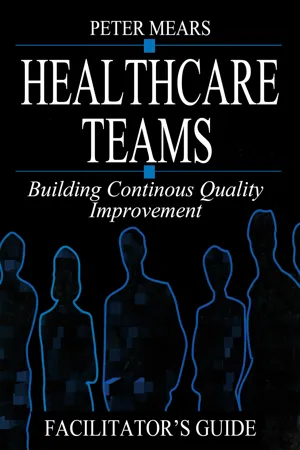
eBook - ePub
Healthcare Teams Manual
Building Continuous Quality Improvement Facilitator's Guide
This is a test
- English
- ePUB (mobile friendly)
- Available on iOS & Android
eBook - ePub
Book details
Book preview
Table of contents
Citations
About This Book
This work provides the reader with an understanding of team building in a health care environment, and shows managers how to build a team that is committed to delivering quality. Topics covered include key quality concepts, team exercises, how to be a team member, team empowerment and continuous quality improvement. The facilitator's guide provides all the lesson plans, overhead projection masters and guides to all the exercises necessary for the team leader or trainer to run a teambuilding workshop.
Frequently asked questions
At the moment all of our mobile-responsive ePub books are available to download via the app. Most of our PDFs are also available to download and we're working on making the final remaining ones downloadable now. Learn more here.
Both plans give you full access to the library and all of Perlego’s features. The only differences are the price and subscription period: With the annual plan you’ll save around 30% compared to 12 months on the monthly plan.
We are an online textbook subscription service, where you can get access to an entire online library for less than the price of a single book per month. With over 1 million books across 1000+ topics, we’ve got you covered! Learn more here.
Look out for the read-aloud symbol on your next book to see if you can listen to it. The read-aloud tool reads text aloud for you, highlighting the text as it is being read. You can pause it, speed it up and slow it down. Learn more here.
Yes, you can access Healthcare Teams Manual by Peter Mears in PDF and/or ePUB format, as well as other popular books in Business & Operations. We have over one million books available in our catalogue for you to explore.
Chapter 1
Teamwork and Synergy
Objective
To explain the concept of teams, assign students to teams, and get students to appreciate the diversity and knowledge of the various team members
Pages
Pages 1–14 in Healthcare Teams: Building Continuous Quality Improvement
Exercises
1 Knowing Your Team Members
Transparencies
1-1 Advantages of Teamwork
1-2 Major Elements of Synergy
1-3 Characteristics of an Effective Team (Part 1)
1-4 Characteristics of an Effective Team (Part 2)
1-5 What Have I Gotten Into?
After assigning each participant to a team, use the transparencies you created from the transparency masters to guide the review of the quality contributors. Let the teams “run over” on Exercise 1, but afterward remind them to gauge their completion time better.
Advantages of Teamwork

Major Elements of Synergy
▪ Listening and clarifying
Concentrate on what is being said
▪ Supporting
Create a positive climate
▪ Quality
Make a personal commitment to improve
▪ Acceptance
Respect other members’ viewpoints
▪ Feedback
Honest communication
Characteristics of an Effective Team (Part 1)
▪ The atmosphere is informal and relaxed, without obvious tension.
▪ There is much discussion in which everyone participates.
Discussion is focused.
▪ The team’s task is understood and accepted by the members.
▪ Members listen to each other! Every idea is given a hearing.
▪ The team is comfortable with disagreement and does not avoid conflict simply to keep everything in agreement.
Characteristics of an Effective Team (Part 2)
▪ Decisions are reached by a consensus.
▪ Criticism is frequent, frank, and relatively comfortable.
There are no personal attacks.
▪ People are free to express their feelings and ideas on the team’s problems.
▪ When action is taken, clear assignments are made and accepted.
▪ The leader does not dominate, nor does the team.
▪ The team is self-conscious about how it functions and examines how it is performing.
What Have I Gotten Into?
▪ Forming
Stage where the team is first formed.
▪ Storming
Stage where impatience with progress occurs.
▪ Norming
Team members start to help one another out.
▪ Performing
Stage where the mature team understands its strengths and weaknesses.
Members are satisfied with progress.
Members are satisfied with progress.
Chapter 2
Contributors to Continuous Quality Improvement
Objective
To begin the process of working as a team, while applying the thinking of the quality leaders to practical problems
Pages
Pages 15–60 in Healthcare Teams: Building Continuous Quality Improvement
Exercises
2 Deming’s Audit
3 Crosby’s Audit
4 Juran’s Audit
Transparencies
2-1 Continuous Quality Improvement
2-2 Continuous Quality Improvement Overview
2-3 Deming’s Guide to Quality (Part 1)
2-4 Deming’s Guide to Quality (Part 2)
2-5 Deming’s Audit: Assigned Teams (for Exercise 2)
2-6 Exercise 2: Your Analysis
2-7 Crosby: Hangings Will Continue
2-8 Crosby’s Guide to Quality
2-9 Crosby’s Audit (for Exercise 3)
2-10 Exercise 3: Your Analysis
2-11 Juran’s Guide to Quality
2-12 Juran Trilogy 1: Quality Planning
2-13 Juran Trilogy 2: Quality Goals
2-14 Juran Trilogy 3: Quality Improvement
2-15 Juran’s Audit (for Exercise 4)
2-16 Exercise 4: Your Analysis
2-17 JCAHO
After assigning each participant to a team, use the transparencies you created fr...
Table of contents
- Cover
- Title Page
- Copyright Page
- Preface
- Table of Contents
- Introduction
- 1 Teamwork and Synergy
- 2 Contributors to Continuous Quality Improvement
- 3 Empowerment
- 4 Supportive Team Cultures
- 5 Team-Building Phases
- 6 Understanding How We Think
- 7 Member Service Roles
- 8 Expanded Team Member Roles
- 9 Expanding Team Skills
- 10 Teams, Teams, and More Teams
- Appendices